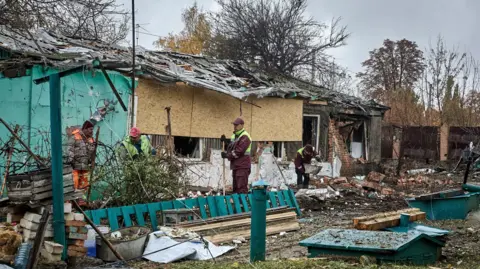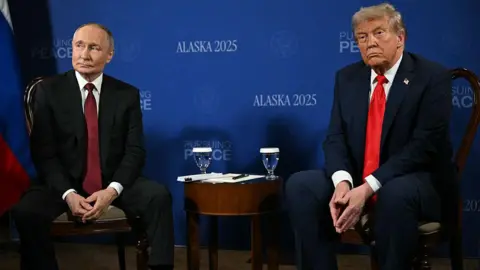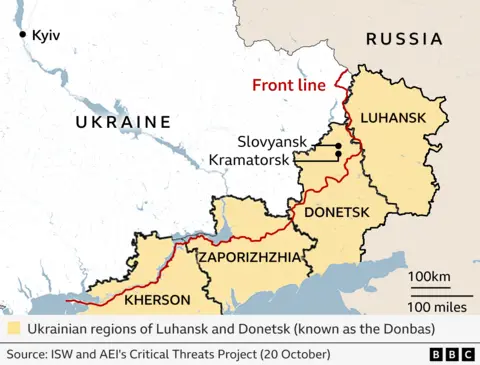Anthony ZurcherNorth America Correspondent
 Environmental Protection Agency
Environmental Protection AgencyReports of an upcoming summit between US and Russian leaders appear to be greatly exaggerated.
Just days after Donald Trump said he planned to meet with Russian President Vladimir Putin in Budapest – “in about two weeks” – the summit was suspended indefinitely.
The preliminary meeting of the two countries' top diplomats was also cancelled.
“I don’t want this meeting to be a waste,” President Trump told reporters at the White House on Tuesday afternoon. “I don’t want to waste any time, so I’ll see what happens.”
The on-again, off-again summit is just the latest twist in Trump's efforts to end the war in Ukraine, an issue that has returned to the US president's attention after he negotiated a ceasefire and the release of hostages in the Gaza Strip.
Speaking in Egypt last week to mark a ceasefire agreement, Trump made a new request to Steve Witkoff, his top diplomatic negotiator.
“We have to get Russia to finish,” he said.
But the circumstances that made the Gaza breakthrough possible for Witkoff and his team may be difficult to replicate in the war in Ukraine, which has raged for nearly four years.
Less leverage
According to Witkoff, the key to the agreement was Israel's decision to attack Hamas negotiators in Qatar. The move angered America's Arab allies but gave Trump an opportunity to pressure Israeli Prime Minister Benjamin Netanyahu to make a deal.
Trump has benefited from a long history of support for Israel dating back to his first term, including his decision to move the US embassy to Jerusalem, changing America's position on the legality of Israeli settlements in the West Bank and, most recently, his support for Israel's military campaign against Iran.
In fact, the US president is more popular among Israelis than Netanyahu, a position that has given him unique influence over the Israeli leader.
Add in Trump's political and economic ties to key Arab players in the region, and he has the diplomatic muscle to push through an agreement.
In the war in Ukraine, by contrast, Trump has much less leverage. Over the past nine months, he has oscillated between attempts to put pressure on Putin and then Zelensky, all to no apparent effect.
Trump has threatened to impose new sanctions on Russian energy exports and provide Ukraine with new long-range weapons. But he also acknowledged that it could undermine the global economy and lead to a further escalation of the war.
Meanwhile, the president publicly scolded Zelensky, temporarily halting intelligence sharing with Ukraine and halting arms sales to the country – only to then back down in the face of worried European allies who warn that Ukraine's collapse could destabilize the entire region.
Trump likes to tout his ability to sit down and work out agreements, but his face-to-face meetings with Putin and Zelensky appear to have brought the war no closer to resolution.
 Getty Images
Getty ImagesIn fact, Putin may be using Trump's desire to get a deal done—and his belief that he can get deals done personally—as a means of influencing him.
In July, Putin agreed to the Alaska summit just as it seemed likely that Trump would sign a congressional sanctions package backed by Senate Republicans. Subsequently, the adoption of this law was suspended.
Last week, as reports circulated that the White House was seriously considering sending Tomahawk cruise missiles and Patriot anti-aircraft batteries to Kyiv, the Russian leader called Trump, who then touted a possible summit in Budapest.
The next day, Trump received Zelensky at the White House. but left empty-handed after a supposedly tense meeting.
Trump insisted Putin was not playing him.
“You know, I've been played by the best all my life, and I did very well,” he said.

But later the Ukrainian leader noted the sequence of events.
“As soon as the issue of long-distance mobility became a little further away for us – for Ukraine – Russia almost automatically became less interested in diplomacy,” he said.
So in a matter of days, Trump went from brooding over the prospect of sending missiles to Ukraine to planning a summit in Budapest with Putin and privately pressuring Zelensky to cede all of Donbass, including areas that Russia had failed to conquer.
He eventually settled on calling for a ceasefire along the current battle lines, but Russia refused to accept it.
During the campaign last year, Trump promised that he could end the war in Ukraine within hours. He has since reneged on that promise, saying ending the war was proving more difficult than he expected.
It was a rare recognition of the limits of his power – and the difficulty of finding a basis for peace when neither side is willing or able to afford to give up the fight.








